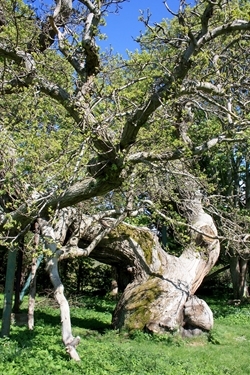Sweet chestnut
 At this time of year, under big old gnarled and twisted sweet chestnut trees (Castanea sativa), the vibrant green fruit-husks called ‘cupules’ litter the ground, resembling a colony of spiky sea urchins. Usually, they have split slightly open to reveal three or four shiny, rich brown nuts hidden away inside.
At this time of year, under big old gnarled and twisted sweet chestnut trees (Castanea sativa), the vibrant green fruit-husks called ‘cupules’ litter the ground, resembling a colony of spiky sea urchins. Usually, they have split slightly open to reveal three or four shiny, rich brown nuts hidden away inside.
The summer of 2018, with its intense heat and long, sunny days, has suited the sweet chestnut well, helping the trees to produce some of the biggest chestnuts that I can remember in this country. This is not particularly surprising, as the species was originally native to Iraq, Turkey and Greece, so thrives in long, hot summers.
Sweet chestnut catkins measuring between 10-20cm, appear in late June and July, and they hold the flowers of both sexes, with male flowers in the upper part and female flowers in the lower portion. These flowering catkins are a great favourite with bees.
The Romans were reckoned to have brought the sweet chestnut to the UK, and across Europe it has been cultivated for over 2,000 years for its edible, starchy nuts. These chestnuts were once a staple food across southern Europe often being ground into flour or coarse meal. It was also an important food supply for stock, especially pigs. Today it is more of a delicacy, making speciality bread, biscuits and cakes.
The world record for the oldest known sweet chestnut specimen (over 2,000 years old), as well as the greatest tree girth ever, is the Hundred Horse Chestnut (Castagno dei Cento Cavalli) beside Mount Etna in Sicily. When measured in 1780, its centre was hollowed and had split into a ring of separate trees, measuring at a supposed circumference of 190 feet (58m) Nowadays, it has deteriorated to a ring of three tree fragments, measuring around 52 feet (16m) in circumference.
The name of this massive, ancient tree is a little confusing, as it is definitely a sweet chestnut and not a horse chestnut. The tree’s name originated from a legend in which a queen of Aragon and her company of 100 knights, during a trip to Mount Etna, were caught in a severe thunderstorm, so the entire company is said to have taken shelter under the tree!
Arguably, Britain’s biggest sweet chestnut tree, which is no challenge for the Sicilian giant, measures in at around 14 metres in girth and is found in the grounds of Canford School in Dorset. We also know that the old sweet chestnut in the park of Stourhead, Wiltshire, was planted in 1500, making it 518 years old.
Because of its high tannin levels, chestnut wood is rot-resistant and has traditionally been used to make outdoor objects such as posts, fencing, and stakes. It is also prized for making furniture, roof beams and barrels.
Chestnut wood was already used in the 18th century for the storage of wines. Wine and cider develop a sweeter taste when stored in chestnut and white wine tends to develop a rosé tinge.
Research has shown that sweet chestnuts probably have allelopathic effects on other plant species growing nearby. That is, chemicals in the leaves that are released into the leaf litter of the forest floor inhibit the germination and the growth of other tree species’ seedlings nearby.
Along with almost all tree species that I write about nowadays, sweet chestnut also has a new disease that it needs to contend with. Several cases of the sweet chestnut blight have been found in England since 2011.
Sweet chestnut blight is caused by a fungus of Asian origin called Cryphonectria parasitica. The disease has caused severe losses of American sweet chestnut (Castanea dentata) in North America. In continental Europe the disease has caused regionally significant losses of sweet chestnut, and in many European countries the disease is now widespread.
I know that sweet chestnut is a non-native species, but it will, in my opinion, be a great shame if in future years you cannot stand under a twisted, cavity-ridden, spooky old sweet chestnut tree as the light begins to fade, and let your imagination run wild!
PS: Despite our long, hot summer favouring chestnut production, we still have some way to compete with our European neighbours. I have just heard from friends in Pensol, France, that their biggest, record-breaking chestnut this year was a whopping 42g and was the size of a squash ball!
Peter Thompson
Advisory
Read more from Peter Thompson at his blog.
Photo credit: Stephen Dickson